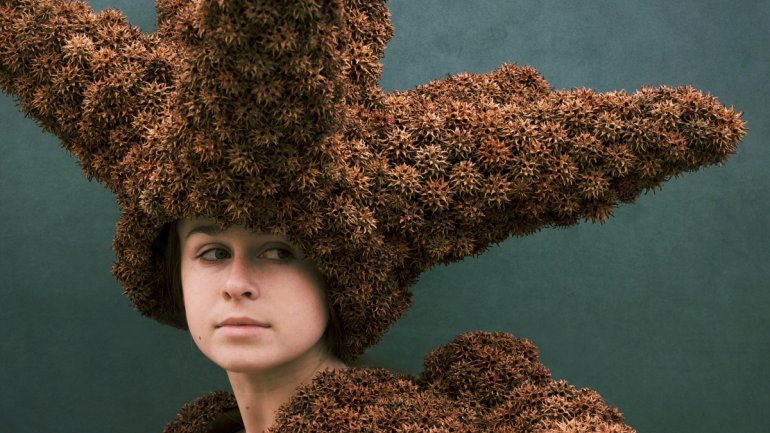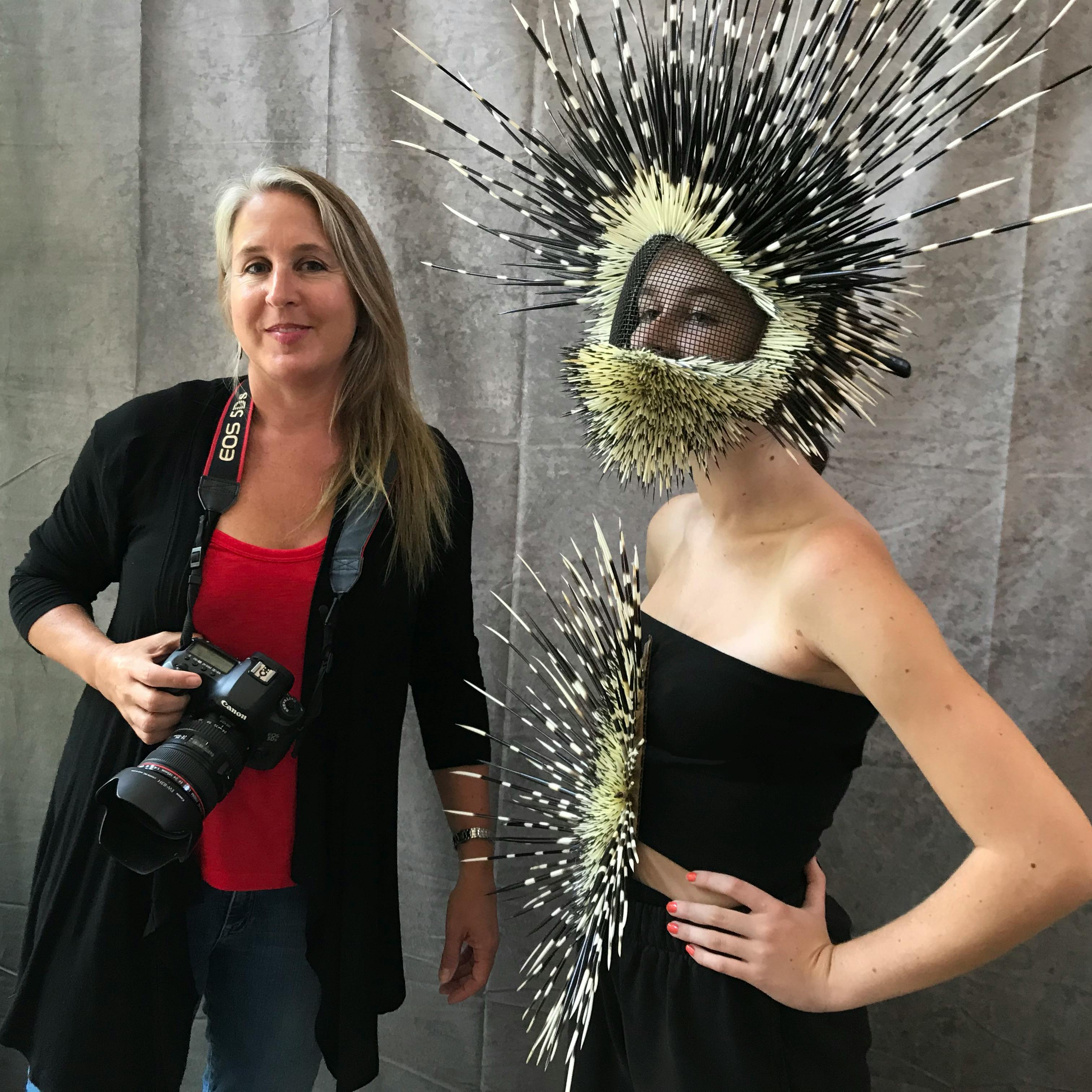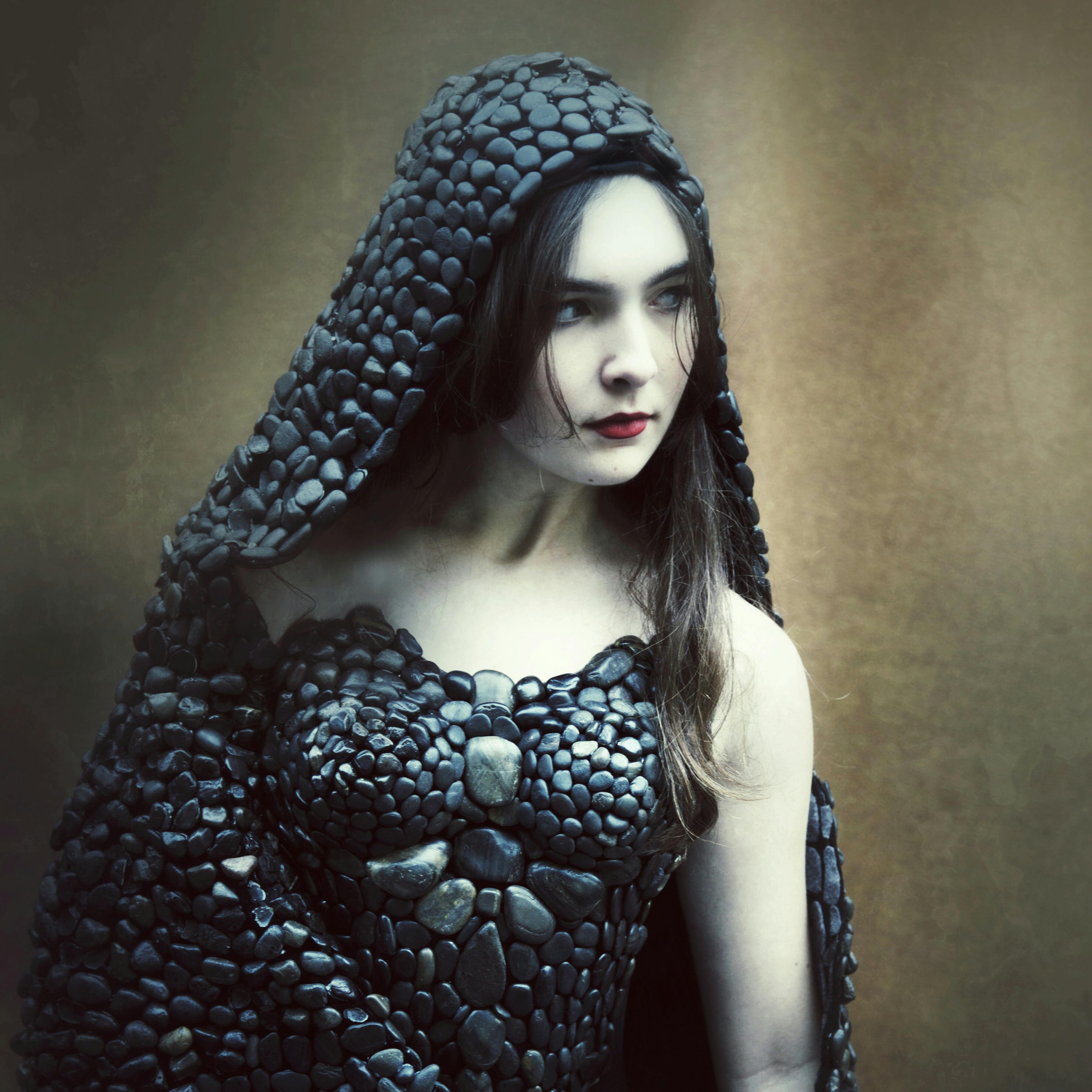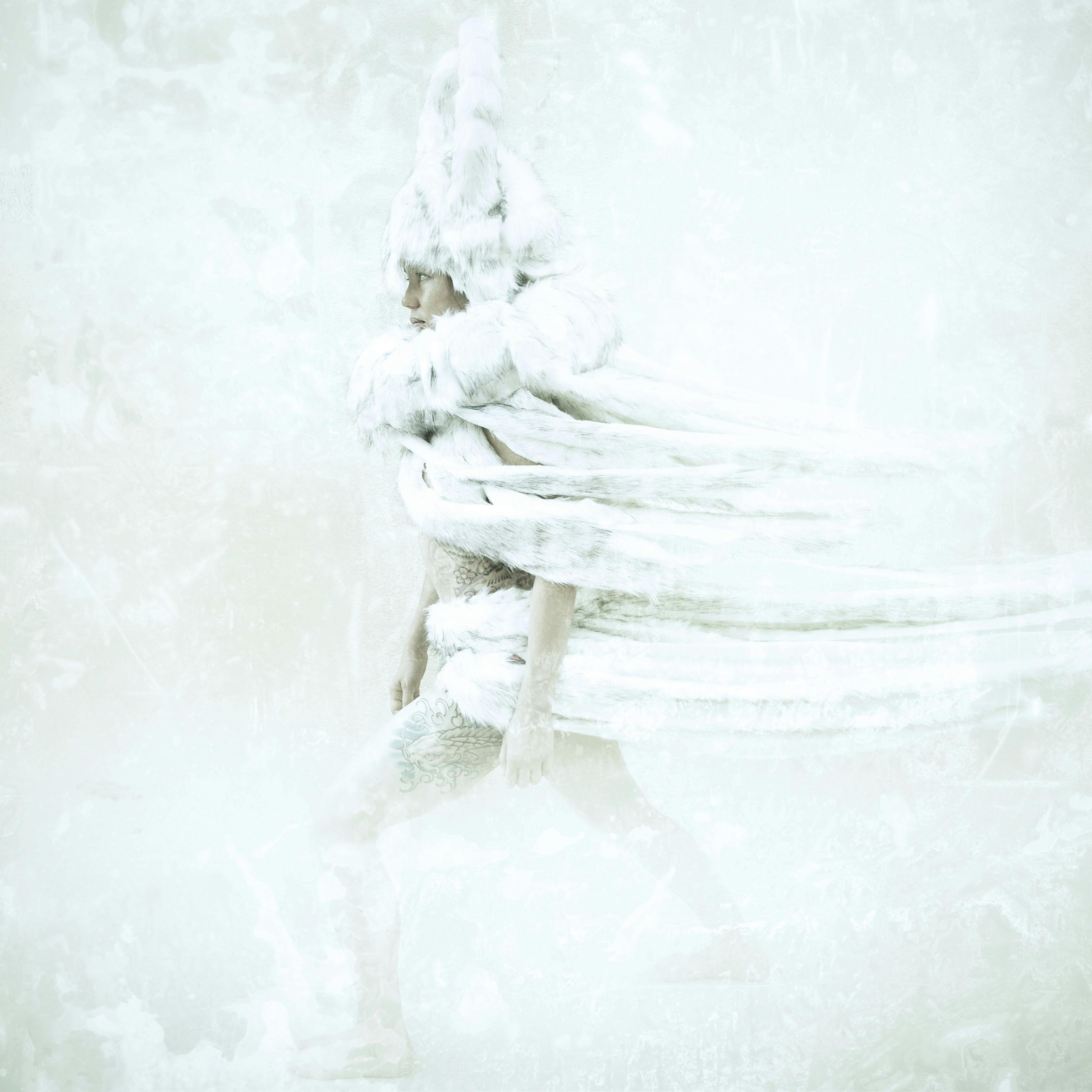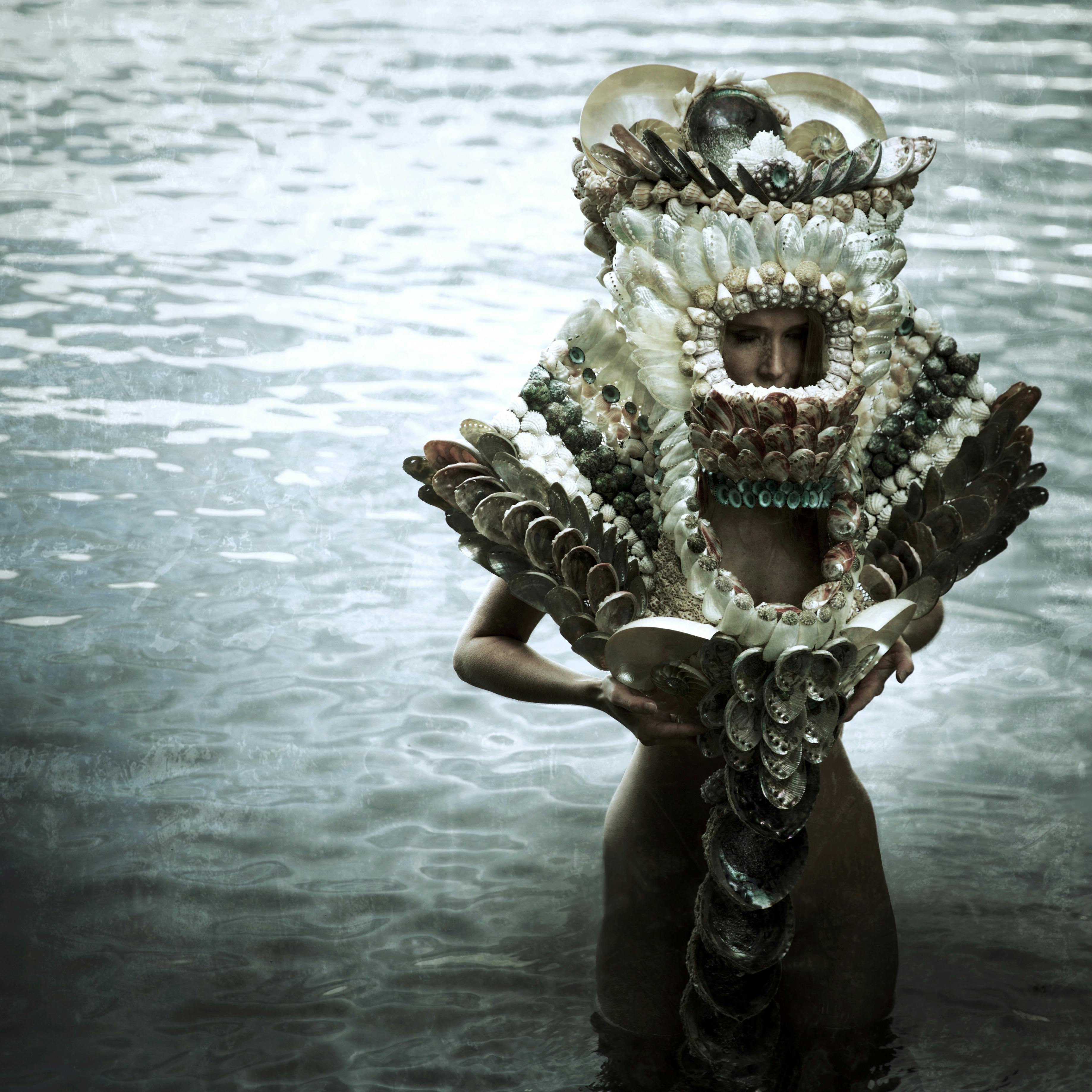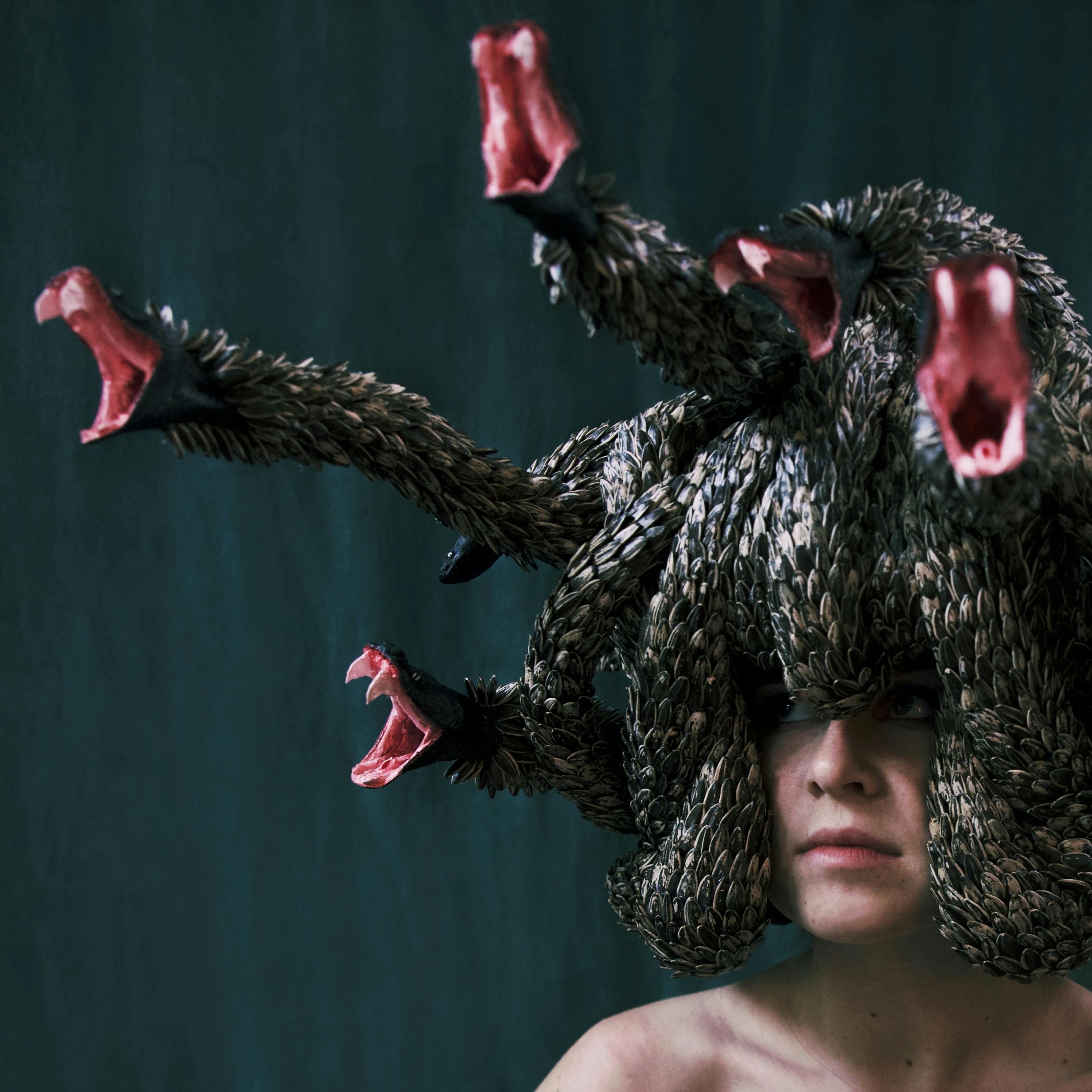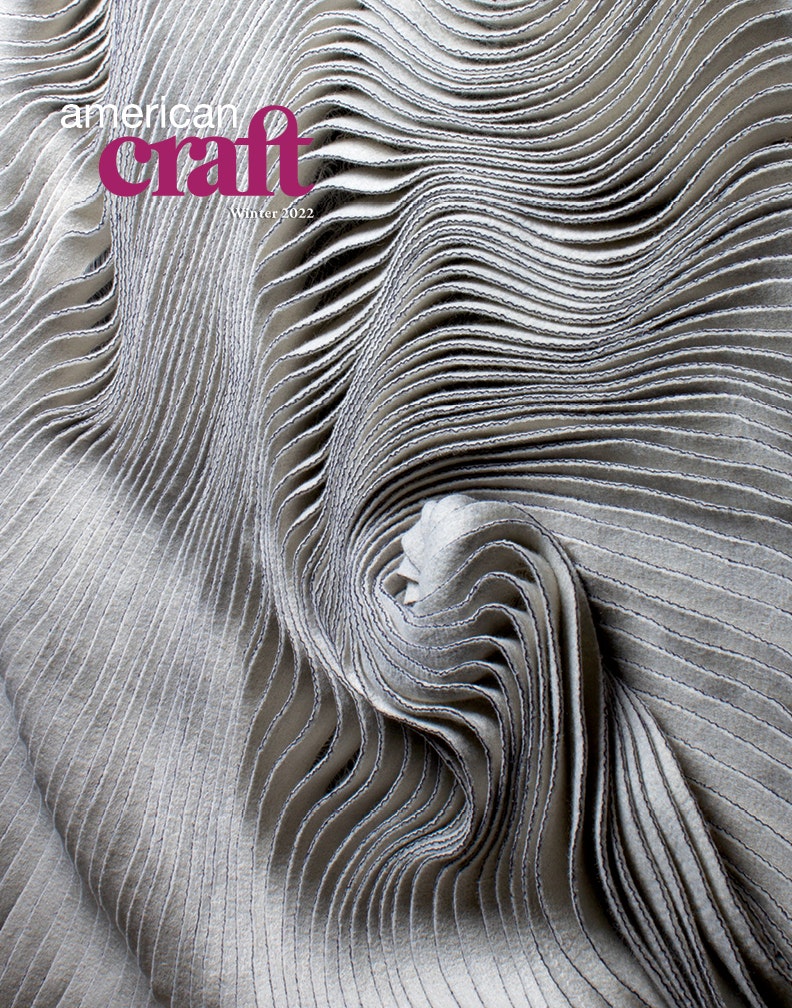Metamorphosis
Metamorphosis
Melissa Meier made Sweet Gum Balls, 2021, from the fruit of liquidambar trees. She loves their coral-like texture when bunched together. Photo by Melissa Meier.
“It’s safe to say these models are logical extensions of me—my warrior side and my softer side,” says the artist, who seeks to portray the power, delicacy, and sensuality of women through her work.
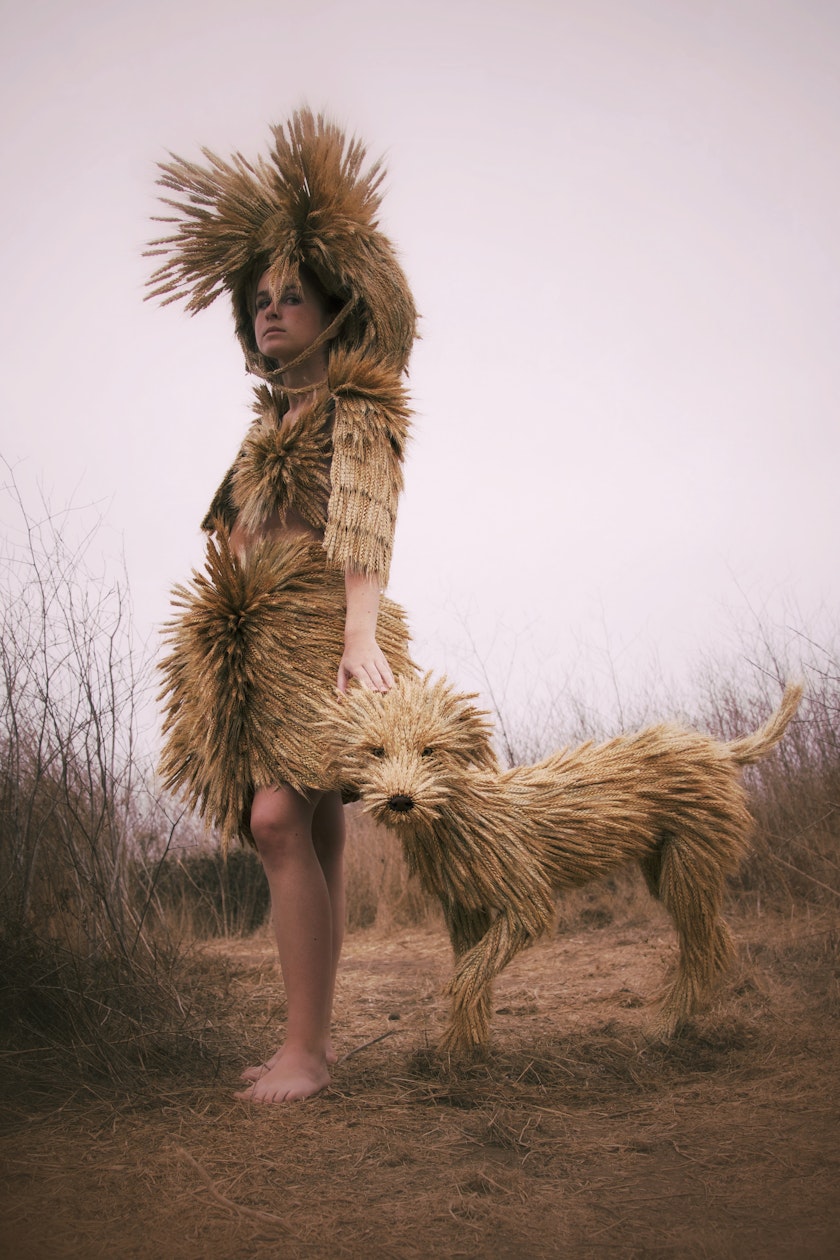
For Wheat, Meier photographed a sculptural dog on a path she and her actual pet dog have frequented. Photo by Melissa Meier.
Rendered from sponges, stones, seashells, sticks, wheat, pine cones, porcupine quills, moss, lavender, sunflower seeds, crystals, corn, and more, the Skins project was sparked in 2012 by a magnolia tree dropping its big, glossy green-and-gold leaves onto Meier’s lawn in Santa Monica, California. “Each leaf had its own unique shape and pattern—they were so beautiful, and I wanted to find a way of working with them,” says Meier, who stitched the leaves together by hand, affixed them to a mesh underlining for structure, and created an outfit for her daughter, Sofia, who was 8 at the time. Designed with tiers of overlapping leaves sweeping down from a strapless bodice and paired with a fantastical cone-shaped hat trailing a swooping tail, the creation was like an illustration from a fairy tale or a fragment of a half-remembered dream.
Although that dress has long since crumbled into compost, it lives on in the moody photographs Meier took of her daughter. More than mere documentation, these collectible portraits breathe life into the inert—allowing Meier to contextualize the sculptures and imbue them with a narrative power and emotional resonance.
“I was especially mesmerized by the spectacular display of costumes and floats at Carnival and the elaborate outfits my mother made for me to wear.”
—Melissa Meier
TOP: Meier during a photo shoot with a model wearing pieces made from porcupine quills (no animals harmed). Photo by Freddy Macdonald. RIGHT: Meier created Moss, 2019, out of lightweight moss and fabric for her daughter Sofia to wear to an art opening. Photo by Melissa Meier.
Viewed as a body of work, Meier’s Skins photography describes an alternate mythological universe or ancient matriarchal civilization populated by goddesses, warriors, queens, and sprites. These images meet the viewer’s projections halfway, all but demanding our personal interpretations. A woman wearing a flowing hooded cloak made of black river stones radiates a Game of Thrones–meets–Rick Owens primal strength. Another—her face covered by a fencer’s mask sprouting porcupine quills—evokes a fierce Boudica, the Celtic warrior leader. The ice queen clad in white faux fur garments (lifted for the photo by wires, to appear wind-swept) might have blown in from Narnia, while an elaborate outfit made of a grotto’s worth of seashells (gathered after a hurricane on a Florida beach by Meier’s parents) appears to enrobe Venus rising from the sea. And Sofia’s posture when wearing a Medusa head made of writhing, sunflower-seed snakes with open red clay mouths manages to convey the vulnerability of the oft-maligned gorgon.
While Meier is quick to proclaim her indifference to fashion qua fashion, some works seem runway ready—such as a geometric, faceted dress made of popcorn and kernels that has the avant-garde chops of a piece by Comme des Garçons’ Rei Kawakubo. “Over time I have become interested in fashion as an extreme form of kinetic sculpture,” says Meier, who wanted this piece to feel futuristic, “as if it could fold into itself like an origami.” Working on a dress form, Meier constructed the polygonal framework out of fabric-reinforced cardboard, fitting the panels like pieces of a puzzle. Popped corn provides the textured surface, while the boundaries are defined with an assortment of colored kernels.
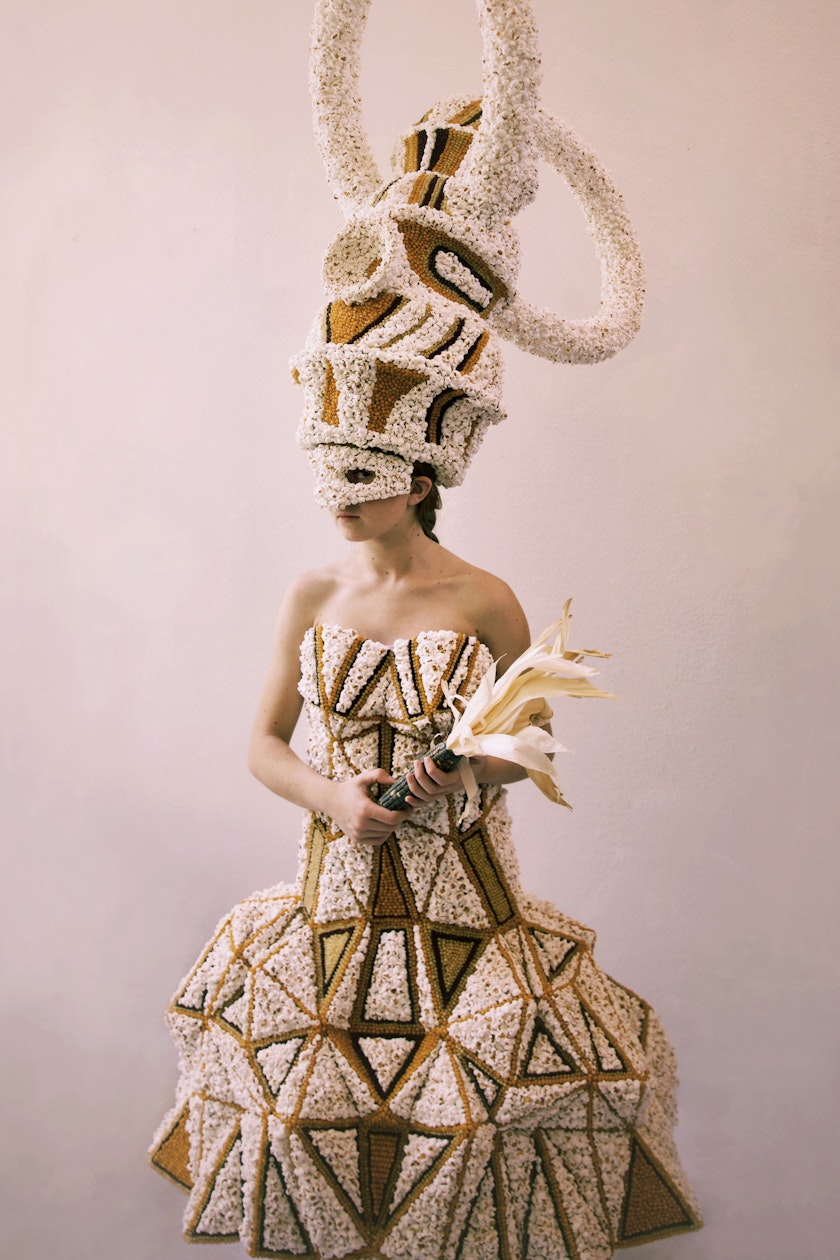
Of interest to Meier in Corn, 2020, is the contrast between irregular shaped kernels and the dress’s strict geometry. Photo by Melissa Meier.
Equal parts camouflage, adornment, and armor, the Skins simultaneously protect and expose their wearers, who dwell in a natural habitat that is at once familiar and otherworldly. “As I work—stitching, arranging, gluing—I take on a meditative state, almost becoming one with the material as I repurpose what is already incredibly beautiful,” says Meier, who hopes for her audience to feel this same sense of wonder as they consider familiar objects in unfamiliar ways.
Meier takes a catholic approach to materials, finding inspiration everywhere. Some elements, such as crow feathers, pine cones, and the spiky pods of the sweet gum tree, are foraged on hikes. Others are gifted to her—like the massive box of fresh lavender sent unsolicited by a Russian fan who discovered her work on Instagram. And a few—eggs, rice, pasta—are plucked from the pantry.
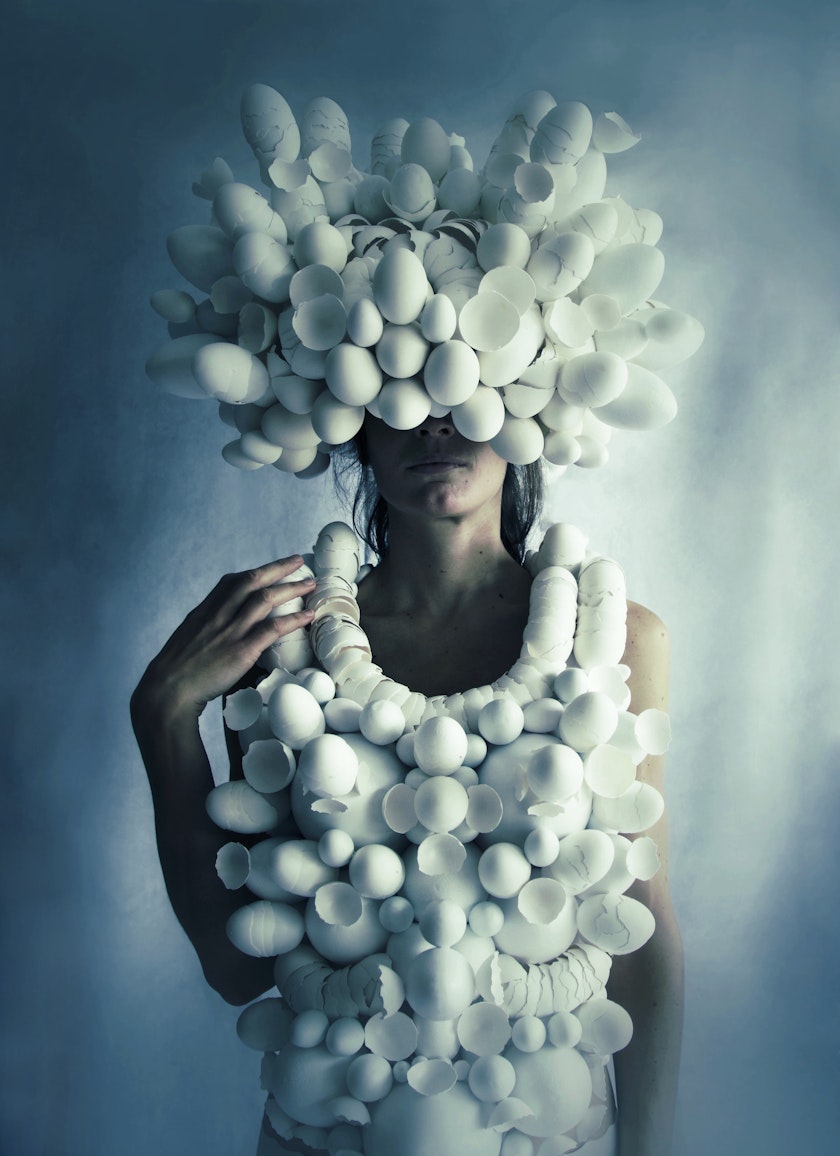
Egg Shells, 2019, the most demanding of the Skins series, was made using hundreds of discarded eggshells that sometimes literally cracked in Meier’s hands. Photo by Melissa Meier.
According to Meier, by far the most demanding of the Skins series is the outfit she made from hundreds of discarded eggshells while living in Switzerland, where her family moved in 2014. She began by shaping the body and conical headpiece from an underpinning of metal mesh: “I wanted the piece to feel both masculine—with a kind of phallic helmet—and feminine, with body-hugging curves.” Then she applied the shells (chicken, ostrich, and quail), utilizing both the concave and convex surfaces for greater depth. “During adhesion and the photo shoot, the shells would literally crack in my hands,” recalls Meier, who had to surrender to the material and work on the fly—replacing broken pieces as needed.
Soon after returning from Zurich in 2019, Meier began experimenting with rice. She decided to practice working with the finicky grains by first making a simple face mask, cutting a smooth resin piece to the desired shape and covering it, one grain at a time, with brown and white rice to accentuate contours and patterns. “The grains began to look as though they were about to sprout, and the beautiful effect spurred me to finish the exceedingly tedious work with tweezers and glue,” says Meier, who also created a hat and capelet using dark wild rice, red rice, and brown rice.
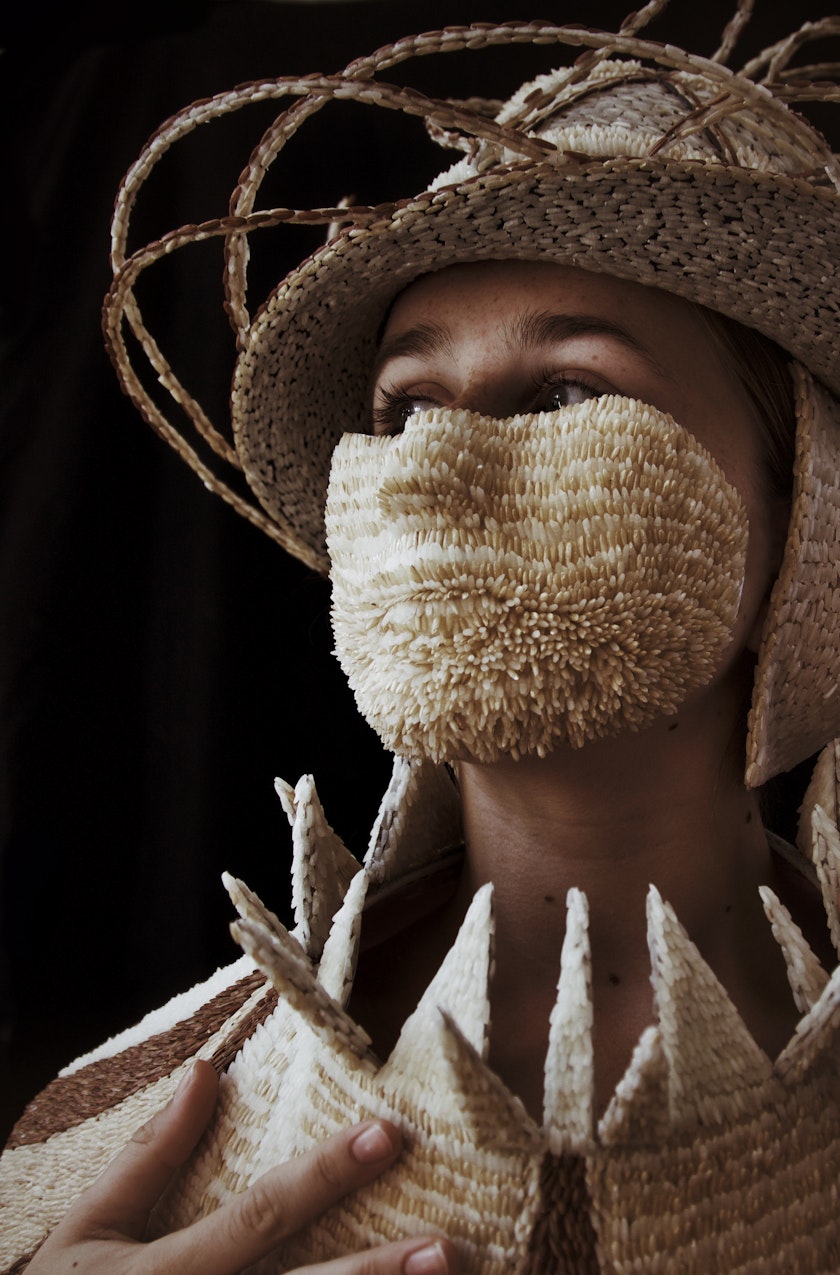
Rice, 2019, was created before the pandemic using brown and white rice grains, tweezers, and glue. Photo by Melissa Meier.
Working with found materials is in Meier’s DNA. Born in the United States to a Brazilian mother and Swiss father and raised in Rio de Janeiro and São Paolo, Meier started making art at a young age, using whatever scraps were on hand. As her family traveled extensively, she immersed herself in the archeology and mythology of other cultures, including Brazil. “I was especially mesmerized by the spectacular display of costumes and floats at Carnival and the elaborate outfits my mother made for me to wear,” she recalls.
After graduating in 1991 from ArtCenter College of Design in Pasadena, California, Meier spent six months in Japan before moving to New York. Although her degree was in illustration, she was always drawn to work in three dimensions and to use photography as a tangential medium. Commissioned in the ’90s by the New York Times Book Review to create cover art for its weekly Sunday publication, for example, she would gather objects that expressed her response to the featured book and create Joseph Cornell–type dioramas, which were then photographed and published as illustrations. At the same time, Meier was showing her own artwork, collages that incorporated vintage photography and found objects such as rosaries, old Barbie dolls, pocket watches, and other treasures retrieved from flea markets, antique stores, and trash bins.

When Meier made Head in the Snow, 2015, from the recycled paper and tape used to ship her family furniture during a move, it weighed over 250 lbs. Photo by Melissa Meier.
Perhaps Meier’s biggest (literally!) achievement repurposing stray materials happened after she was surrounded by piles of packing detritus following the family’s relocation to Switzerland. “I thought, why not make something from all this stuff?” The result was Head, a 7-foot-long, 250-pound sculpture constructed entirely from brown packing paper and clear tape. “We lived near a forest, and I would roll this massive thing down the road to take photographs or drive to the country with it half-sticking out of the car, and people looked at us like we were crazy,” recalls Meier. Posed on its side in the forest mist, perched beside a campfire, resting lakeside, or lightly dusted with snow, Head appears strangely poignant, like some misplaced artifact from Easter Island.
There are echoes of Head in another of Meier’s ongoing projects, a series of oversized masks called Glass-Eyed. Made of papier-mâché covered with clay and fitted with glass eyes for a greater depth of expression, they come alive when photographed on a model, who humanizes them with a tilt of the head, a curl of the body, or a gesture of the arms. “Masks are a form of disguise, ritual, entertainment, and even protection,” says Meier. “But what interests me are the ways in which they reveal—rather than conceal—human emotion. They are able to suggest feelings such as pain, fear, melancholy, and solitude that, for whatever reason, I might be unable to express for myself.”
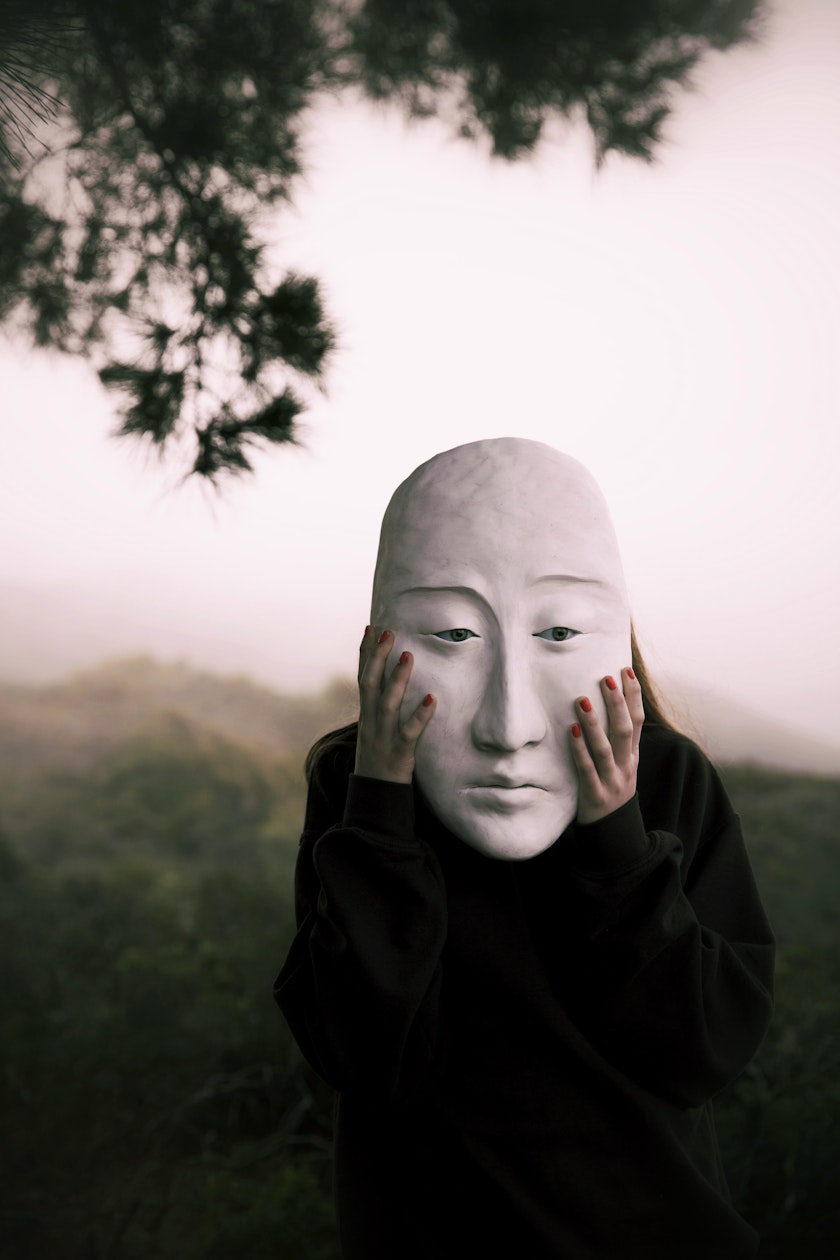
Meier creates masks that express emotion rather than to conceal it, such as in Pondering Mask, 2021, made from papier-mâché and clay with glass eyes. Photo by Melissa Meier.
Humor is another emotion that Meier channels through her work, especially where animals are involved. A portrait of her daughter clad in sheaves of wheat, like a harvest deity, includes a companion dog—a variation on a wheaten terrier. And stems of eucalyptus leaves perfectly evoke the bristling fur and rigid whiskers of an arched-back cat whose hackles are up, particularly when posed atop the helmet of her leaf-bedecked daughter.
Although Meier has dabbled in nonorganic materials, such as faux fur, she remains riveted by the natural world and looks forward to working with eucalyptus pods and rainbow hues of dried heirloom beans. (Chewed gum is another material she has been contemplating, although the logistics remain elusive.) Says Meier, “I’m committed to materials that decompose, molt, and otherwise degrade, not only as a way of expressing my feminine side, but as a means of symbolizing our precious time as humans: how we need to appreciate every waking minute, and—at the same time—how we need to let go when it’s time.”
melissameierart.com | @melissameierart
Discover More Inspiring Artists in Our Magazine
Become a member to get a subscription to American Craft magazine and experience the work of artists who are defining the craft movement today.
